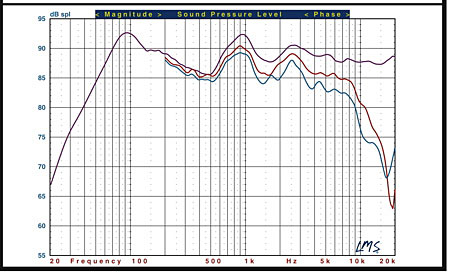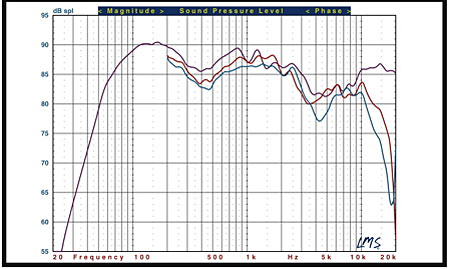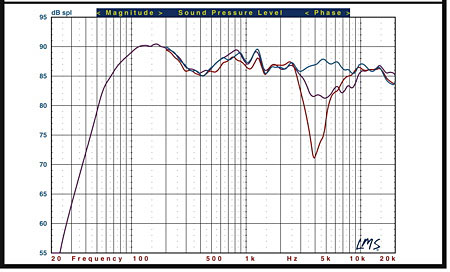The Sonus faber DOMUS Surround Sound System Measurements
The measurements shown were made with the grilles removed. While the grilles did not make a dramatic change in the response, they did produce a less even response in the mid and upper treble.
The Grand Piano DOMUS is tuned to 36Hz. I agree with Sonus faber's nominal impedance rating of 4Ω, though it does dip below 4Ω from 89Hz-172Hz, with a minimum value of 3.5Ω at 107Hz. But the impedance phase angle remains remarkably benign across the full audible range. Any amp comfortable with a 4Ω load should have no trouble with this speaker. The Grand Piano DOMUS' sensitivity measured approximately 89dB/2.83V/meter.
The horizontal front response of the Grand Piano DOMUS is shown in Fig.1 (violet). This is the pseudo-anechoic response averaged over a 30° forward horizontal angle, taken at tweeter height, combined with the nearfield responses of the woofers and port.

Fig.1: Sonus faber Grand Piano DOMUS, pseudo-anechoic response beyond the horizontal axis at 45° (red) and 60° (blue)
The Grand Piano DOMUS's averaged front horizontal response has a significant dip at 500Hz, fairly close to the rated lower crossover frequency of 400Hz. This dip is not deep enough (a maximum of about -4dB) to cause major problems, but might be the cause of the laid-back midrange that MF notes in the review (though this dip is in the heart of the midrange, not the upper midrange). There's a small peak at 950Hz followed by another (smaller yet) dip at 1.5kHz. The off-axis results follow the on-axis average fairly closely until the inevitable rolloff at high frequencies. The dip at 500Hz aside, the averaged response is within a respectable tolerance of plus or minus about 2.5dB from 600Hz to 20kHz, with particularly smooth and extended high frequencies. The latter are also shelved down just a little, which confirms the sweet top end MF heard. The useful low frequency limit, however (-10dB relative to the level at 150Hz), is a modest 38Hz.
The vertical response characteristics, shown in Fig.2, suggest that the vertical listening axis is fairly critical. You'll hear the best balance with your ears positioned as close as possible to tweeter height. If you must deviate from that, lower is better than higher.

Fig.2: Sonus faber Grand Piano DOMUS, pseudo-anechoic response at 15° above (red) and 15° below (blue) the tweeter axis
The Center DOMUS's impedance dropped to a minimum value of 3.6Ω at 156Hz. Its ported cabinet is tuned to 63Hz. Sonus faber's rated nominal impedance of 4 Ω is appropriate. The impedance also has a benign phase angle, though a little less so than is the case with the Grand Piano DOMUS. The Center's sensitivity measured approximately 87dB/2.83V/m, and the speaker should be an easy load to drive for any 4Ω-capable amp.
The measured front horizontal response of the Center DOMUS, taken on the tweeter axis and averaged in the same manner as described above for the Grand Piano DOMUS, is shown in Fig.3 (violet curve). The effective bass extension is approximately 52Hz (-10dB relative to the output at 150Hz). The on-axis response shows a dip at 400Hz similar to that seen in the Grand Piano DOMUS. (It may well contribute to the low-level dialog intelligibility that MF comments on.) There's also a broad dip centered at around 5kHz, but more on that below. The off-axis response follows these same deviations, but also shows the positive effect of a 3-way center design. Apart from an additional suckout in the 60-degree response, the horizontal off-axis aberrations follow those of the on-axis average, without any of the additional suckouts nearly always found in two-way (woofer-tweeter-woofer), horizontally-configured center speakers.

Fig.3: Sonus faber Center DOMUS, pseudo-anechoic response beyond the horizontal axis at 45° (red) and 60° (blue)
The vertical response measurements in Fig.4 do suggest a way to mitigate the Center's broad suckout at 5kHz, shown in Fig.3. The Fig.3 responses were taken on the tweeter axis. But as Fig.4 shows, the dip disappears at a listening position Below the tweeter. This will be ideal for a center channel located on top of a big screen television, which will place it above the listeners' ears. But on a solid stand (preferably) or shelf below the screen, the listeners' ears will be above the tweeter. While MF did not comment on any sonic differences in the two placements, there is an easy solution for the lower mounting location: Turn the Center Domus upside down if you use it on a low stand!

Fig.4: Sonus faber Center DOMUS, pseudo-anechoic response at 15° above (red) and 15° below (blue) the tweeter axis
(When heard on axis, the Center's 5kHz suckout could also further contribute to a degraded low level intelligibility by reducing the audibility of mid-treble vocal consonants that let us distinguish, for example, between P and T. At higher levels, however, these sounds, some of which are called fricatives, will be less annoying with such a response dip because they are often exaggerated in movie soundtracks.)
MF loved the sound of the Domus system, and it is possible that the response variations we measured in both the Grand Piano DOMUS and Center DOMUS, particularly those at around 500Hz, are the result of deliberate voicing. Yet I know that Sonus faber does design flatter speakers; check out the review of their Amati anniversario in Stereophile. That speaker does cost 6-times as much as the Grand Piano DOMUS, but linear response through this region is not just a matter of price.
Violet (all figures): pseudo-anechoic response on the tweeter axis, averaged across a 30° horizontal window, combined with near-field responses of the woofers and port. Apart from the low frequency measurements (woofers and port), all measurements were taken at 1 meter
























































